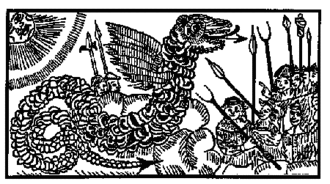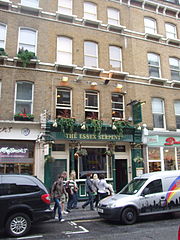Henham Dragon

The Dragon of Henham ( English Henham Dragon ) is a legendary dragon creature reportedly seen in the village on 27 and 28 May 1668 Henham in Uttlesford , Essex , was spotted. He was described as a winged serpent that attacked villagers and eventually disappeared into a nearby forest. This event was reported in a pamphlet called The Flying Serpent, Or Strange News out of Essex , which may have been anonymously authored by the poet William Winstanley .
content

OR
Strange News out of
ESSEX
BEING
A true Relation of a Monstrous Serpent which hath divers times been seen at a Parish called Henham-on-the-Mount within 4 miles of Saffron Walden .
Showing the length, proportion and bigness of the Serpent, the place, where it commonly lurks, and what means hath been used to kill it.
Also a discourse of other serpents, and particularly of a Cocatrice killed at Saffron Walden.
“The place of his abode and where he hath been often seen, is called Henham, but most commonly Henham on the Mount, the town standing upon a hill, having many fair farms and granges belonging to it, in one of which named The Lodge , near to a wood called Birch-wood, by reason of the many birches growing there, in a pasture-ground close by the same, hath this monstrous Serpent been often seen upon the sides of a bank, beaking and stretching himself out upon the same at such time as Sol did parch the earth with his refulgent beams. "
“Her whereabouts and the place where she was often seen is called Henham , but mostly Henham on the Mount , that town is situated on a hill and includes numerous farmhouses and farms of medium size, one of which is called The Lodge Near a forest, called Birch-wood because of the many birches that grow there, on a willow-ground near it, this monstrous snake was often seen on either side of a mound on which it was writhing and stretching at the time Sol seared the earth with its shining rays. "
The first person the snake met was a rider, on whose horse the snake pounced and who was so terrified at the sight of the creature that he gave his mount the spurs and fled into the village. Shortly afterwards, two other men met the snake, but despite armed with flails and poles, they did not dare to attack the creature, which apparently showed no shyness. Larger numbers of peasants were also unable to tackle the snake. Eventually she retired to a nearby forest where the farmers kept watch, hoping to kill the animal, which ends the pamphlet story.
The snake is described as about eight to nine feet long, which is roughly two and a half to three meters. The smallest part of the snake was about the size of a human lower leg, the middle part was the thickness of a human thigh. It had large eyes (about the size of a sheep), two rows of sharp, white teeth in its mouth and a pair of wings. However, due to their small size (about two hand spans in length), the latter were not able to support the being's body. However, this did not prevent the author of the pamphlet from titling it with " The Flying Serpent " ( German Die Fliegende Schlange ).
origin

The author of the pamphlet is unknown. It was printed and sold by Peter Lillicrap in Clerkenwell in 1669 . The first page only mentions "a church chief, a constable , an overseer of the poor " and four household heads as witnesses to the events. Today a copy of the pamphlet can be found in the Saffron Walden Museum .
The story of the Henham Dragon joins a series of alleged dragon or giant snake sightings in Sussex and Essex . In addition to the flying snake, the pamphlet also contains reports on other snakes and a basilisk that was allegedly killed in nearby Saffron Walden , where the work was also published. George Monger notes that the report on the appearance of the dragon is similar to more recent reports on unidentifiable animals and, because of the way it is portrayed, eludes an objective verifiability.
In her biography Ingenious William Winstanley about the poet William Winstanley, who lived in Essex in the 1660s, the author Alison Barnes claims that he was behind the events surrounding the dragon of Henham. Together with his nephew Henry Winstanley , the builder of the first Eddystone lighthouse , the poet built a model of the kite out of wood and canvas , in which a person could have found a place. This supposed dragon is said to have been moved by a man in the area of Birchwood and so upset the local farmers. Then, according to Barnes, Winstanley wrote the pamphlet about the kite anonymously. He tried to appease possible skeptics by naming the seven eyewitnesses, who, however, were all close friends of Winstanley and his nephew. In this context, Barnes also refers to the woodcut of the dragon contained in the pamphlet: On it both the serpent creature and the peasants and the smiling sun show a happy face, as if they were laughing at the hoax . The author also suspects that Winstanley himself sold the work in his bookshop in Saffron Walden. Other authors like Richard Pusey also follow this view.
reception
The legend of the Henham dragon was very popular shortly after the pamphlet was published. In May 1674, five years after the pamphlet was published, Saffron Walden is said to have held the Henham Fair , a festival where villagers sold small statues of the dragon. This festival lasted for 265 years, until the outbreak of World War II in 1939. In addition, the local breweries there sold a beer called Snakebite ('snake bite', not to be confused with the beer- cider mixture Snakebite ), of which Poor Robin's Almanack 1674 reported. However, there is also a lack of clarity here: Neither the historian Ralph Whitlock in the 1970s nor his colleague George Monger at the beginning of the 1990s managed to find evidence of the festival or the beer brand on site.
In this context, Monger again points to a possible authorship of the Winstanleys for the Almanack . Poor Robin is said to allude to Robert, the younger brother of Henry Winstanley; this thesis was also represented by Sidney Lee , among others .
The town sign of Henham shows a winged dragon as does the village magazine , Dragon Magazine . For a long time there was a pub in the London borough of Covent Garden called The Essex Serpent . It was replaced by shops in the 18th century, but later reopened and can still be visited today. The design and decor company Design Toscano added the Henham Dragon to its collection: There it adorns the pommel of a walking stick alongside other dragons such as the Lambton Worm .
References
See also
- List of Dragon Locations - Overview of locations where dragons are reported
literature
- Albert Clifton Kelway: Memories of Old Essex. Read Books, 2008. ISBN 1-4097-6472-9 , pp. 265-266.
- George Monger: Dragons and Big Cats. In: Folklore , Vol. 103, No. 2 (1992), pp. 203-206.
Web links
- www.henham.org - official homepage of the place
Individual evidence
- ↑ a b Henham Dragon ( Memento of August 8, 2009 in the Internet Archive ) www.henham.org. Retrieved October 24, 2009.
- ^ A b c Albert Clifton Kelway: Memories of Old Essex. Read Books, 2008. ISBN 1-4097-6472-9 , p. 265.
- ↑ a b c George Monger: Dragons and Big Cats. In: Folklore , Vol. 103, No. 2 (1992), pp. 203-206.
- ↑ Henham Dragon Walking Stick of Dawood Castle. ( Memento of January 8, 2012 in the Internet Archive ) Retrieved November 14, 2009.

